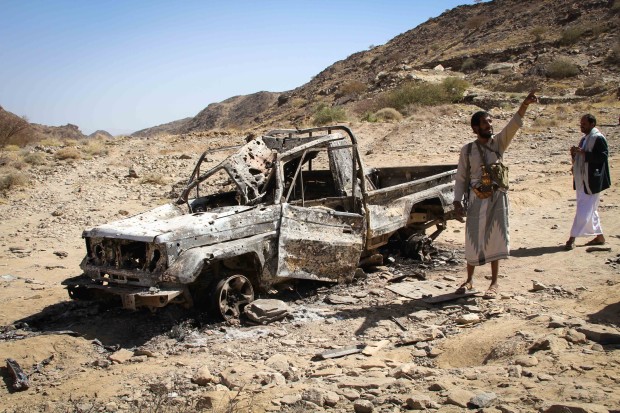By Peter Salisbury
The Riyadh Agreement, signed on 5 November, has averted a war within Yemen’s civil war, at least for the time being. The deal prevents a collapse of the fragile alliance of Yemeni forces that Saudi Arabia has supported since intervening in Yemen in March 2015 to prevent Huthi rebels from taking over the country. The question now is whether the agreement can act as a bridge to a nationwide political settlement or if it simply marks a pause before another round of violence.
By signing, the two parties to the agreement – the internationally recognised government of Yemen, led by President Abed Rabbo Mansour Hadi, and the secessionist Southern Transitional Council (STC) – have ended a three-month standoff that threatened to split the anti-Huthi bloc. In August, simmering tensions between STC-aligned forces and the Hadi government boiled over following the killing of a senior STC military commander. The Huthis claimed the attack, but the STC suspected a government hand in the event and soon took Aden by force. The STC then attempted to consolidate control over all the territory of the former south Yemen, an independent state prior to 1990, with the goal of declaring self-rule. The government charged the UAE, the STC’s main backer and at the time the leading player in the Saudi-led coalition in the south, with supporting a coup, and launched a counteroffensive. With the Saudis’ Yemen campaign in peril, the kingdom’s deputy defence minister, Prince Khaled bin Salman, intervened, calling the STC and Hadi government first to Jeddah and later to Riyadh in the hope of reaching a compromise.
The agreement calls for formation of a new, Aden-based, 24-member government comprising equal numbers of northern and southern ministers and for integration of STC-affiliated forces into national military and security structures as part of an initiative that will see fighters and heavy weapons removed from towns and cities across the south. In addition, it stipulates that the STC be included in government delegations to future UN-led talks with the Huthis over a political settlement to end the war.
Diplomats and UN officials say they are hopeful that the agreement will clear a path to a national-level political settlement. For the time being, the deal halts government-STC fighting that would have strengthened the Huthis and delayed the prospect of national peace talks. It also makes prospective talks more inclusive, helping address a shortcoming of previous UN-led talks, which were built around an April 2015 Security Council resolution that frames the conflict as a two-sided war between the Huthis and the government and effectively demands that the Huthis surrender. The Hadi government may have international legitimacy, but it does not represent the full assortment of political and military forces that make up the anti-Huthi bloc, particularly the separatists, whose agenda the Hadi government rejects but who have a strong presence on the ground.
The Riyadh Agreement places Saudi Arabia at the epicentre of Yemeni deal making. Khaled bin Salman will oversee its implementation and thus help shape the new government and security structures. The Saudis have also assumed coalition command in the south from the Emiratis, who have been withdrawing their forces from Yemen. Beyond the STC-Hadi talks, Saudi officials have reportedly been convening senior politicians from Yemen’s major parties in the hope of uniting anti-Huthi groups under one political umbrella.
Meanwhile, in the north, discussions between the Huthis and Saudis over a de-escalation of cross-border attacks and front-line fighting have been inching along since September. If these talks succeed, a reduction in the conflict’s intensity could be a starting point for a nationwide ceasefire and facilitate the opening of political talks between the rebels and a more broadly representative government delegation. The Saudis thus have a chance to bring the various channels of negotiation together into a national political process under UN auspices.
The Riyadh Agreement, however, bears hallmarks of past intra-Yemeni deals that have failed. It is loosely worded, likely because vagueness was required to induce the rivals to sign it, and it leaves a number of questions around implementation unanswered. For example, the deal calls for both formation of a new government and a series of security sector reforms in Aden within 30 days of signing. The reforms include the formation of new mixed security forces, the removal of military units from the city and the transfer of heavy weapons to sites that the Saudis will oversee. But the deal does not specify in which order the parties are to take these steps. The Hadi government would prefer that the security track proceed first, as a prerequisite for movement on the political side; the STC would prefer it the other way around. Other outstanding issues include who will get the posts of defence and interior minister in the new-look government, with both being potential deal-breakers for the STC.
Most importantly, neither side seems to have fully bought into the compromise to which they agreed on paper. A signing ceremony for the deal had been scheduled for 31 October, but it was postponed after fighting between STC and government forces in Abyan governorate, to the east of Aden. In common with past deals, delays and mutual recriminations can be expected once implementation begins. A return to fighting in the south is certainly in the realm of the possible.
A pivot to national political talks is by no means guaranteed, either. The Huthis say that talks with Riyadh are going well but that the Saudis are moving too slowly doing their part in de-escalation. They also report Saudi troop buildups along key front lines and worry that the Riyadh Agreement may presage a concerted military push against them. From their side, Hadi government officials say they are unsure what Riyadh plans after the deal, but concede that a reinvigorated campaign against the Huthis is an attractive option. In fact, part of the STC’s sales pitch for Saudi patronage – which its leaders believe they have now secured – was willingness to play a stepped-up role in or even lead the fight against the Huthis.
In any case, lasting peace will not come easily to Yemen. The main parties to the conflict have barely changed their positions since the beginning of the war: the Hadi government wants the Huthis to hand back Sanaa and other areas they control. The Huthis demand a power-sharing arrangement that gives them significant weight in a unity government. The STC and its allies want to break away from Yemen altogether. The Saudis want the Huthis to sever ties to Iran, give up heavy weapons to the state security forces and guarantee border security. The gaps between these positions are not minor. Nonetheless, for the first time in years, a viable, albeit bumpy, pathway to peace is in view.
Peter Salisbury is a consulting senior analyst on Yemen for the International Crisis Group, where this piece originally appeared.





